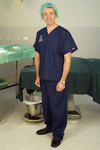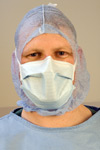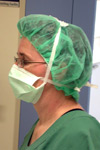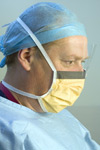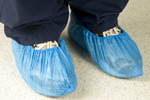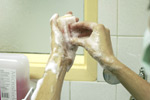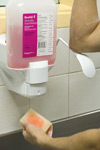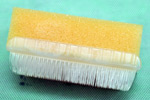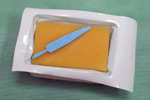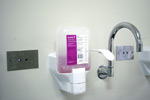Preparation of the Surgeon/Operating Personnel
Unit 1: Non-Sterile Barriers
In preparing for surgery, the surgeon should make use of a number of initial but important non-sterile barriers to minimize the source of potential contaminants such as hair, clothing fibres and dirt from the sterile field. This will involve the wearing of non-sterile and non-linting clothing and barriers such as masks and head covers, as well as the use of antiseptics to minimize the number of bacteria on the surgeons hands.
Topic 1: Scrub suits
Freshly laundered scrub suits provide clean, comfortable clothing for use in the operating room. As they are made from cotton, they also provide a good barrier between the surgeons skin and the surgical environment.
Street clothes should not be worn under the scrub suit, in particular any clothing which might shed lint such as woolen jumpers.
With two-piece suits, loose fitting tops should be tucked into the trousers.
Ideally, scrub suits should also not be worn outside the surgical environment and should be protected with a laboratory coat if unavoidable.
Topic 2: Surgical head covers
Hair and scurf shed from the head are potentially significant sources of contamination in the surgical field. Surgical caps are used to minimize the contamination from the head. Caps are commonly used and should ideally cover all of the hair. Balaclava style hoods are also available for surgical staff who wear beards.
Most surgical head covers are designed for single use. Cotton caps are also used, but must be freshly laundered prior to each surgical session.
Topic 3: Face masks
A number of face mask designs are available, but in general all masks act as a filter between the surgeons mouth and nose and the patient. They act to filter out droplets of moisture containing micro-organisms expelled from the mouth and nasopharynx during talking, sneezing and coughing.
Whilst some surgeons use re-usable masks made from lint-free cotton material, it is preferable to use disposable, single-use masks composed of a lint-free material containing a hydrophilic filter sandwiched between two outer layers.
Masks should be fitted and tied completely around the mouth and nose to prevent venting to the side of the face.
Most masks also contain a flat wire insert which is used to assist in conforming the top of the mask to the bridge of the nose.
Masks that help in preventing fogging of spectacles are also available and contain a foam insert between the mask and nose.
Some facemasks incorporate a clear plastic visor and can be used in surgical procedures in which some aerosols or sprays might be produced. Protective glasses are also available.

Link to download Surgical Operational procedure - pdf (495Kb)
Topic 4: Shoe covers
Street shoes should not be worn into the operating theatre. Ideally, only shoes designed or designated for use in the surgical environment should be worn into theatre.
Shoe covers have not been shown to reduce contaminants within the operating theatre however they may be useful for protecting dedicated surgical clogs from blood or bodily fluid during surgical procedures.
Additionally the act of donning shoe covers, may in fact be detrimental due to the possibility of contamination from the soles of the shoes being transferred to the hands.
Topic 5: Surgical Skin Scrub
It is impossible to "sterilise" skin. The aims of the surgical scrub is to:
- remove dirt and oil from the hands and forearms.
- reduce the surface transient microbial count.
- prolong the depressant effect of the antiseptic used on the resident microflora.
A number of scrub solutions are available. Selection should be based on the theoretical properties of an ideal skin preparation which include:
- a wide spectrum of antimicrobial activity
- an ability to decrease microbial counts quickly
- quick application
- a long residual effect
- activity in the presence of organic matter
- safe to use on the skin
- economical
Prior to scrubbing, all rings, watches and bracelets should be removed.
Fingernails should be short, clean and free of nail polish and artificial nails.

Recommended Reading:The World Health Organization Guidelines on Hand Hygiene in Health Care and Their Consensus Recommendations • Infection Control and Hospital Epidemiology. July 2009, Vol. 30, Issue 7, p611-622, 12p.
Most scrub solutions contain an antiseptic agent and a detergent to give a foaming lather and improved mechanical removal of debris. Common antiseptics used in scrub solutions include:
Povidone Iodine
eg. PVP, Povidone-Iodine, Betadine
These iodophors have a broad-spectrum of activity against bacteria, are fungicidal,virucidal and sporicidal (with prolonged contact).
They work by the slow release of active iodine, but have minimal residual activity and are inactivated by organic material.
A relatively high incidence of skin reactions are also reported.
Chlorhexidine
eg. CHG, Hibiclens, Hibiscrub
Chlorhexidine has a broad spectrum of activity (not some pseudomonas spp) but minimal action against spores and viruses. It has a rapid speed of action and good residual activity (up to 6 hours). It is also active in the presence of organic material. Very occasional skin reactions are produced. Chlorhexidine is common choice of antiseptic due to its residual activity.
Alcohol/Chlorhexidine or Alcohol/Povidone-Iodine
Alcohol is usually used in most skin preparations in combination with the other agents. It has a broad spectrum antibacterial action which is improved in combination with chlorhexidine or povidone-iodine.
It has some residual activity but causes skin irritation and tissue necrosis in open wounds as a result of damage to the lipids in the cell membranes and protein precipitation.
The majority of research suggests 0.5% Chlorhexidine in 70% Isopropyl alcohol is superior to all other products for surgical skin or surgical scrub antisepsis.
Please Note: Some individuals experience varying degrees of skin reactions to one or more of these antiseptic agents. Alternative scrub solutions are available.
Skin scrubbing is also aided by the use of a scrub brush. These are single-use antiseptic impregnated or dry brushes. The bristle side is only used for scrubbing under the finger nails, whilst the sponge side is utilised for the hands and arms.
Single-use scrub brushes have a plastic pick in the packet to help cleaning dirt from under the fingernails. This should be performed before the scrub is commenced.
Care should also be taken not to scrub the hands and forearms too aggressively as this may remove the superficial skin layers and expose deeper resident skin flora.
Traditional Water Based Scrub Protocol:
Open the surgical sponge before wetting the hands and arms. Leave the sponge within the packaging on a safe surface.
Throughout the scrub, the hands should be held above the elbows and away from the body so that the scrub suit does not get wet.
A pre-wash is performed before the surgical scrub commences.
The taps are turned on by either an elbow control or automatic sensor.
The hands and forearms (just above the elbow) are wetted.
The scrub solution is dispensed from either a foot or elbow operated dispenser.
Scrub solution is applied to all wet surfaces and a general wash is performed.
Both hands and arms are thoroughly rinsed under running water.
Reapply a generous amount of the scrub solution over both hands and arms ensuring coverage to just above the elbows.
Current recommendations for a surgical hand scrub is for a timed procedure(3-5 minutes) rather than the old fashioned anatomical scrub, where a number of brush strokes were dedicated to each surface of the fingers, hand and arms.
Additionally surgical brushes with bristles are no longer recommended except for use underneath the finger nails.
Start the surgical scrub at the finger tips (bristles may be used, change to the sponge side before moving onto the hands), moving across each finger, between webbing as well as ensuring you scrub both sides of the hands. Continue in circular motions around the wrist, towards the elbow. Finish just above the elbow.
Rinse your sponge under running water. Add more Chlorhexidine if required and complete the scrubbing procedure on the other hand and arm.
Starting with the first hand and arm, fully rinse the detergent off under the tap, move to the second hand and arm to repeat the rinsing, then allow all water to drain into the sink before moving to the sterile towel/s and gown.
Alcohol Based Hand Rub Method (ABHR) - With 0.5% Chlorhexidine
The World Health Organization (WHO), the Center for Disease Control (CDC) and the Association of Operating Room Nursing (AoORN) have written hand hygiene guidelines, including a surgical hand scrub protocol for health practicesl. Their current recommendations are that an alcohol based hand rub, particularly with an antiseptic agent with residual action is superior to the traditional water based surgical hand scrub.
Whilst many veterinary practices may still be utilising the traditional water based scrub, it should be noted that either or must be carried out before any sterile surgical procedure is undertaken.
Alcohol hand rub must be applied to clean dry hands.
If hands are visibly dirty, wash hands and arms with a non-medicated soap, then dry the hands and arms with clean papaer towel.
For the first surgical scrub of the day clean under the nails with a nail pick, prior to dispensing ABHR's.
Dispense a pump (2ml) of hand prep onto one palm. Dip fingertips of the opposite hand into the hand prep and work under finger nails.
Spread hand rub over all aspects of your hands moving upwards to just above the elbows.
Repeat the above process for the second hand.
Dispense a final pump of hand prep into either hand and reapply to all aspects of both hands up to the wrists.
Allow the hands and arms to air dry. Do not use a towel.
Once hand rub has completely dried, pick up the sterile gown and commence gowning and gloving.

Link to download Surgical Operational procedure - pdf (495Kb)

